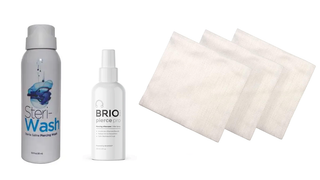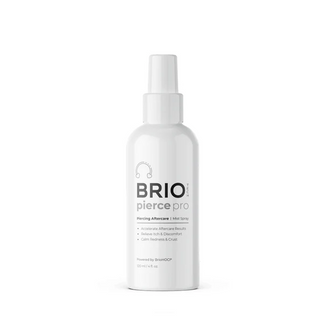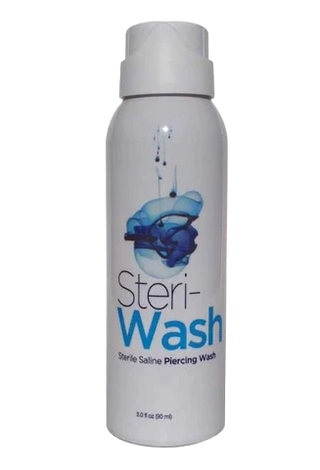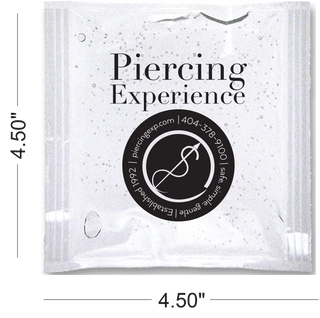
General Aftercare Information
Now that you’ve received your piercing, it’s your responsibility to take good care of it until your piercing fully heals.Your main responsibility is to actively keep your piercing from getting dirty in the first place. And yes, it is an active process, not just “doing nothing.” So what does this mean?Pair text with an image to focus on your chosen product, collection, or blog post. Add details on availability, style, or even provide a review.
Our basic philosophy
Protect your piercing so it doesn’tget hurt or dirty in the first place.
Be gentle with your piecing so your immune system can heal it.
Taking good care of your overall health is important. No one likes to hear it, but your nutrition, sleep habits, and hydration levels can and do affect healing. Make sure you eat a healthy diet, get enough sleep, and drink plenty of water. Avoiding alcohol, smoking, and other drugs will also benefit your piercing.
Be careful in the shower. Showering can introduce bacteria or irritants from shampoos, conditioners, soaps/body washes, etc. Tap water can have chlorine and hard minerals. These irritants can rinse into a piercing and cause swelling, prolonged healing, or even lead to scar tissue. Watch for snags!
Facial piercings can be kept out of the spray. Wash your face at the sink and use a clean washcloth or towelette to wipe around the piercing. Don’t splash, as this will rinse face wash and other products into the piercing.
Ear cartilage piercings can be covered with a plastic cup when rinsing hair. If they do get wet, it’s very important to rinse thoroughly with tap water to remove shampoo and other residues. Be sure to then follow the instructions to clean with the saline spray to below.
Earlobe piercings aren’t quite as sensitive as cartilage, but it’s still important to make sure they are rinsed and dried thoroughly after showering. Rinse with tap water, then saline as below. Be sure to dry the backs completely!
Body piercings, like nipples and navels, are harder if not impossible to keep dry. It’s imperative to limit what products come into contact. Shower with a soap that does not contain fragrances, antibacterial ingredients, or moisturizers. NO Dove or Olay products! Instead, use something with simpler chemistry, such as an unscented castile soap (e.g. Dr. Bronner’s).
Keep soap away from the piercing itself.
Avoid personal care products like lotion/makeup. We use a lot of chemicals on our bodies. While these may be OK for intact skin, many of these products will cause irritation in a healing piercing. For safety, keep these products about a quarter size distance from your piercing so they don’t accidentally get in it.
Checkups and Downsizing are Important!
We want to see you for a checkup, generally about 6-8 weeks from the date of your piercing. You will receive a reminder text and/or email.
You’ll probably have an easy time with healing, and that’s great. It’s still important to let our piercers take a look at your piercings. If everything is going great, we’ll let you know!
For shorter healing piercings, such as earlobes, we can let you know if your piercing is healed or needs more time. It’s important to be sure your piercing is healed before you change jewelry or stop care.
Things to Avoid
DON’T Touch It. The main causes of infection are dirty fingers and dirty fluids. Keep both your and your friends’ fingers away.
DO NOT twist/turn the jewelry or play with it It’s irritating, like picking a scab. If you notice a build-up of material on your jewelry – and the build-up is not attached to your skin – you can gently brush it off the jewelry with DRY sterile gauze.
DON’T Soak It. This will introduce bacteria and irritating chemicals and water-log your piercing. Waterlogged skin is more delicate and susceptible to damage. Soaking has never been shown to improve the healing process.This also means no swimming or baths while your piercing is healing!For nipple or navel piercings, TEGADERMTM or other occlusive bandages can be used to seal your piercing if you swim during healing.
DON’T Use Cotton Swabs/Balls. These products can leave irritating lint on and around your piercing and easily snag on your jewelry. Use non-woven sterile gauze instead!
DON’T Use Harsh Chemicals. No tea tree oil, alcohol, peroxide, antibacterial soap, or ointments. DO NOT use moisturizing soaps like Dove and Olay or antibacterials like Dial. These soap additives leave a residue that builds up in piercing and can contribute to irritation bumps.
DON’T Sleep on It. Sleeping on piercings reduces circulation, delaying healing and causing swelling. The pressure may cause piercings to migrate or change their angle.
DON’T Take Your Jewelry Out. If removed during the healing process, your piercing will close almost immediately. Once healed, it is safe to take your jewelry out long enough to change it, but not longer. As your piercing becomes more established, you’ll be able to leave it out for longer periods.This process can take a year or longer. If you need to hide your piercing for work, or need a non-metallic option for surgery, we can help!

Alternative Aftercare: Hypochlorous Acid
The chemical Hypochlorous Acid (HOCl) has gained in popularity for wound care in recent years. It is produced by your body to reduce inflammation and attack microbes in wounds. Unlike other antibacterials, HOCl is nontoxic and non-irritating. Because of the natural production within the body and the FDA approval of more than 10 formulas for its use, we are comfortable offering these products.
The natural bactericidal and anti-inflammatory properties seem to best address two main types of problems with piercings: persistent swelling and excess buildup. We offer a spray and a gel formula.
When we see piercings, such as cartilage or nipple, that are still swollen long after we expect, we may recommend switching out saline for HOCl spray. If swelling has progressed into a bump on your piercing, we may recommend using the HOCl gel formula to help reduce the bump. It may take a couple of weeks to see noticeable improvement.
Some folks have issues with excessive crusty discharge/buildup on their piercings/jewelry. If this persists with normal cleaning/showering, we may recommend switching to HOCl spray. This product’s anti-inflammatory properties and higher cleaning action will generally clear this up.
When to See a Doctor
Rarely, serious complications can occur in piercings that require a doctor’s intervention. If you have a concern that something is wrong, we do want to see you first! The APP has a great brochure on Troubleshooting problems.If you have any concerns about your piercing, please book an appointment for a checkup to let our piercers assist you.
Infections
Irritation in piercings is much more common than actual infections and can be mistaken for an infection. Irritation can result in redness around piercings, swelling, and/or small bumps forming next to the piercing. Irritation results from physical trauma like snagging or sleeping on your piercing, chemicals like shampoo getting into the piercing, playing with the jewelry, over-cleaning, and/or using harsh aftercare products. The key to clearing up irritation is to remove the source of the irritation and let your immune system heal things. This can take several weeks, depending on the seriousness of the irritation.Infections are caused by germs getting into a piercing, usually by touching the piercing with dirty hands or swimming while a piercing is healing.
Actual infections will need to be evaluated and treated by a doctor. The following are symptoms of an infection:
- Red streaks radiating from the piercing
- Area is hot to the touch
- Discharge is a funny color like green/blue/purple and/or smells bad (Normal discharge will be an off-white to honey color)
- Extreme swelling.
Complete Embedding of your Jewelry
Extreme swelling or trauma to a piercing can cause jewelry to be pulled completely under the skin. It’s vital to make sure this is remedied ASAP. If you can get in within about 48 hours of this happening, our piercers should be able to remove the embedded jewelry and install a larger piece to allow recovery. If the skin actually heals over the jewelry, this would need to be surgically removed by a doctor.




